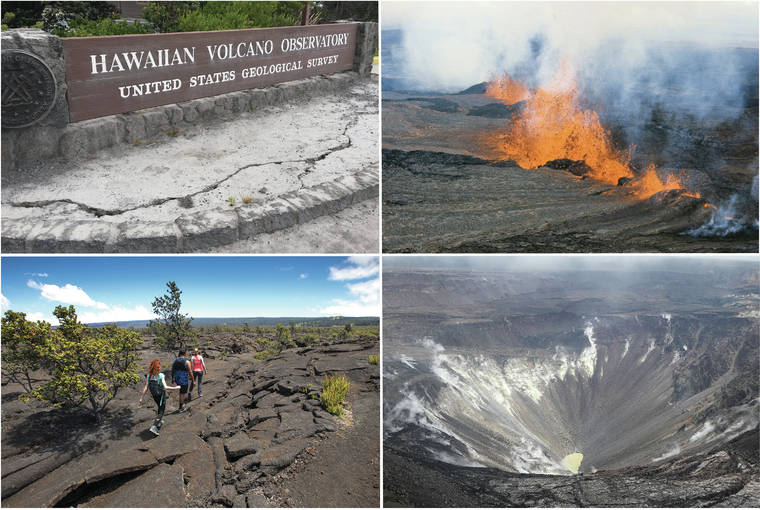HILO — Neither Kilauea nor Mauna Loa erupted in 2019, but this period of relative quiet must not lead to complacency about Hawaii’s two most active volcanoes. Both will eventually erupt again.
Given this fact, Hawaii residents should stay informed and be prepared for the hazards posed by a restless or erupting volcano. As we all learned from Kilauea’s 2018 eruption, the possible impacts — lava flows, ground cracks, poor air quality, evacuations, road closures, and others —can be far-reaching and life-changing.
“Volcano Awareness Month,” held every January since 2010, is one way that residents can learn more about the volcanoes that both inspire and concern us all.
This January, informative and engaging talks and hikes on Hawaiian volcanoes will be offered by the USGS Hawaiian Volcano Observatory (HVO) in cooperation with Hawaii Volcanoes National Park, the University of Hawaii at Hilo, and Hawaii County Civil Defense. All are free and open to the public.
The complete schedule of Volcano Awareness Month programs, including dates, times, locations, and brief descriptions for the talks and hikes offered in January, is posted on HVO’s website (https://volcanoes.usgs.gov/hvo) under “HVO News” (lower left corner of homepage).
For now, here’s a brief overview of the January schedule:
HVO scientists will present “After Dark in the Park” programs every Tuesday evening throughout the month in Hawaii Volcanoes National Park.
Topics addressed in these talks include a recap of HVO’s current situation since relocating to Hilo and what its future may hold, as well as updates on Kilauea and Mauna Loa (Jan. 7); what’s happening at Kilauea Volcano’s summit and the crater lake within Halemaumau (Jan. 14); insight from ongoing research and monitoring on Kilauea’s lower East Rift Zone (Jan. 21); and the unprecedented level of seismicity that occurred in 2018 (Jan. 28). Each program starts at 7 p.m. in the Kilauea Visitor Center auditorium. National Park entrance fees may apply.
Two talks will be offered on the UH-Hilo main campus in the University Classroom Building (UCB) Room 100 at 7 p.m. The first, a repeat of the Jan. 7 “After Dark in the Park” program on HVO’s status and volcano updates, is on Jan. 9. The second program on Jan. 16 will describe how lava samples collected from erupting fissures in 2018 have revealed the complex story of magma that fed the eruption.
On the Kona side of the island, a presentation about damaging earthquakes in Hawaii, including the dramatic seismicity in 2018, and how to prepare for the next “big one” will be offered twice on Jan. 8. The talk will be first presented at the Kailua-Kona Public Library at 3:30 p.m. and then repeated at the West Hawaii Civic Center at 6 p.m.
Programs about Mauna Loa, Earth’s largest active volcano, will be offered in two locations. On Jan. 29, an HVO scientist will talk about the current status and eruptive history of the volcano at the Puuhonua O Honaunau National Historical Park amphitheater at 6 p.m. On Jan. 30, HVO will team with Civil Defense to provide information about Mauna Loa — its current status, potential hazards, how to prepare for the next eruption, and more — in the Ocean View Community Center at 6 p.m.
The 2020 line-up also includes a number of hikes in Hawaii Volcanoes National Park guided by HVO scientists and Park rangers. These hikes include treks through Kilauea Iki, walks through Kilauea Volcano’s summit history, a look at the 1868 Mauna Loa lava flow on a trail in the Park’s Kahuku Unit, and a venture back to the 1969-74 Mauna Ulu eruption. Details about these hikes are provided in the Volcano Awareness Month schedule on HVO’s website.
HVO spearheads Volcano Awareness Month each January because we realize the importance of understanding the spectacular volcanoes on which we live and of being prepared for the next eruption. We hope our 2020 programs will be just the start of your quest to learn more about our volcanic island home.
If you’re unable to attend the Volcano Awareness Month talks and hikes, you can learn and stay informed about Hawaiian volcanoes through HVO’s website. There, you will find volcano updates, monitoring data, geologic histories for Kilauea and Mauna Loa, photos and videos, and much more.
Please visit HVO’s website (https://volcanoes.usgs.gov/hvo) for past Volcano Watch articles, Kilauea and Mauna Loa updates, volcano photos, maps, recent earthquake info, and more. Email questions to askHVO@usgs.gov.
Volcano Watch is a weekly article and activity update written by U.S. Geological Survey Hawaiian Volcano Observatory scientists and affiliates.



